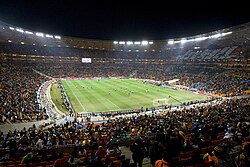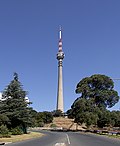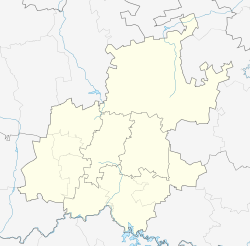
Back Johannesburg Afrikaans ጆሃንስበርግ Amharic Johannesburgo AN جوهانسبرغ Arabic جوهانسبيرج ARZ Johannesburgu AST Yohannesburq Azerbaijani ژوهانسبورق AZB Йоханнесбург Bashkir Johannesburg BAN
Johannesburg
| |
|---|---|
| City of Johannesburg | |
| Nickname(s): | |
| Motto: "Service with Pride"[4] | |
| Coordinates: 26°12′16″S 28°2′44″E / 26.20444°S 28.04556°E | |
| Country | |
| Province | Gauteng |
| Municipality | City of Johannesburg |
| Established | 1886[5] |
| Government | |
| • Type | Metropolitan municipality |
| • Mayor | Dada Morero (ANC) |
| Area | |
• City | 334.81 km2 (129.27 sq mi) |
| • Urban | 3,357 km2 (1,296 sq mi) |
| • Metro | 1,642.6 km2 (634.2 sq mi) |
| Elevation | 1,753 m (5,751 ft) |
| Population (2022)[7] | |
• City | 4,803,262 |
| • Rank | 8th in Africa 1st in South Africa |
| • Density | 14,000/km2 (37,000/sq mi) |
| • Urban | 7,860,781[a] |
| • Metro (2022) | 6,198,000 |
| • Metro density | 3,800/km2 (9,800/sq mi) |
| Racial makeup (2019) | |
| • Black African | 76.4% |
| • White | 12.3% |
| • Coloured | 5.6% |
| • Indian/Asian | 4.9% |
| • Other | 0.8% |
| First languages (2011) | |
| • Zulu | 23.41% |
| • English | 20.10% |
| • Sesotho | 9.61% |
| • Setswana | 7.68% |
| • Afrikaans | 7.28% |
| • Other | 18.10% |
| Time zone | UTC+2 (SAST) |
| Postal code (street) | 2001 |
| PO box | 2000 |
| Area code | 010 and 011 |
| HDI | |
| GDP | US$131 billion (2020)[11] |
| GDP per capita (PPP) | US$16 370 (2014)[11] |
| Website | www |
Johannesburg (/dʒoʊˈhænɪsbɜːrɡ/ joh-HAN-iss-burg, US also /-ˈhɑːn-/ -HAHN-, Afrikaans: [jʊəˈɦanəsbœrχ]; Zulu and Xhosa: eGoli [ɛˈɡɔːli]) (colloquially known as Jozi, Joburg, Jo'burg or "The City of Gold")[12][13] is the most populous city in South Africa. With 5,538,596 people in the City of Johannesburg alone and over 14.8 million in the urban agglomeration, it is classified as a megacity and one of the 100 largest urban areas in the world.[14][15] Johannesburg is the provincial capital of Gauteng, the wealthiest province in South Africa, and seat of the country's highest court, the Constitutional Court.[16] The city is located within the mineral-rich Witwatersrand hills, the epicentre of the international mineral and gold trade. The richest city in Africa by GDP and private wealth, Johannesburg functions as the economic capital of South Africa and is home to the continent's largest stock exchange, the Johannesburg Stock Exchange.[17]
Johannesburg was established in 1886,[18] following the discovery of gold, on what was once farmland. Within a decade, the population surged to over 100,000, driven by the large gold deposits found along the Witwatersrand.[19] Modern Johannesburg is an amalgamation of formerly separate cities, townships and settlements, reflecting apartheid-era spatial segregation policies. Soweto ("South-Western Townships"), designated a "blacks only" city until 1994, is one of the most historically significant areas for modern South Africa. Home to key anti-apartheid leaders, including Nelson Mandela and Desmond Tutu, it became the epicenter of the 1976 Soweto Uprising, where student protests were met with brutal force.[20] In contrast, Lenasia is predominantly populated by English-speaking Indo-South Africans (people of Indian and South Asian descent). Formerly "white-only" areas include Sandton, known as "Africa's richest square-mile", Randburg and Roodeport.[21]
- ^ "Place Names of Pre-colonial Origin and their Use Today". 2 August 2012. Archived from the original on 7 October 2023. Retrieved 7 October 2023.
- ^ "Chilli city". 14 November 2010. Archived from the original on 27 November 2022. Retrieved 27 November 2022.
- ^ "Egoli definition and meaning". Collins English Dictionary. Archived from the original on 8 March 2021. Retrieved 17 July 2018.
- ^ "Johannesburg (South Africa)". Retrieved 7 October 2023.
- ^ Robson, Linda Gillian (2011). "Annexure A" (PDF). The Royal Engineers and settlement planning in the Cape Colony 1806–1872: Approach, methodology and impact (PhD thesis). University of Pretoria. pp. xlv–lii. hdl:2263/26503. Archived from the original on 26 March 2023. Retrieved 13 November 2022.
- ^ a b "Johannesburg". Census 2011. Archived from the original on 7 September 2016. Retrieved 27 November 2017.
- ^ a b Census 2022: Provinces at a Glance (PDF) (Report). Statistics South Africa. 2023. pp. 36, 73. ISBN 978-0-621-51559-6.
- ^ a b Cite error: The named reference
citypopwas invoked but never defined (see the help page). - ^ "Population of Johannesburg". Archived from the original on 20 September 2019. Retrieved 8 September 2019.
- ^ "Gauteng's Human Development Index" (PDF). Gauteng City-Region Observatory. 2013. p. 1. Archived from the original (PDF) on 11 January 2015. Retrieved 1 January 2015.
- ^ a b Top 150 richest cities in the world (Report). 11 March 2020. Archived from the original on 9 February 2014. Retrieved 19 February 2023.
- ^ "Johannesburg: The City of Gold". Johannesburg: The City of Gold. 22 October 2019. Archived from the original on 18 January 2021. Retrieved 17 December 2020.
- ^ "The history of Joburg, City of Gold". SouthAfrica.net. Archived from the original on 27 November 2020. Retrieved 17 December 2020.
- ^ "Statistics South Africa | Census Dissemination". census.statssa.gov.za. Retrieved 23 March 2025.
- ^ "Major Agglomerations of the World - Population Statistics and Maps". www.citypopulation.de. Retrieved 23 March 2025.
- ^ Bhana, Deeksha (2018). "The Constitutional Court as the apex court for the common law of contract: Middle ground between the approaches of the Constitutional Court and the Supreme Court of Appeal". South African Journal on Human Rights. 34: 8–32. doi:10.1080/02587203.2018.1432100. S2CID 149346012.
- ^ "Top 20 | Africa Wealth Report 2024". Henley & Partners. Retrieved 23 March 2025.
- ^ "Johannesburg | City, History, Map, & Points of Interest | Britannica". www.britannica.com. 3 September 2023. Retrieved 5 September 2023.
- ^ Ritchie, Kevin (2 July 2012). "A jubilee that truly sparkles". IOL. Archived from the original on 8 March 2021. Retrieved 10 September 2019.
- ^ "Soweto, Johannesburg | South African History Online". www.sahistory.org.za. Retrieved 23 March 2025.
- ^ Wright, Emily (26 February 2025). "Africa's richest city that's home to over 12,000 millionaires". Express.co.uk. Retrieved 23 March 2025.
Cite error: There are <ref group=lower-alpha> tags or {{efn}} templates on this page, but the references will not show without a {{reflist|group=lower-alpha}} template or {{notelist}} template (see the help page).












